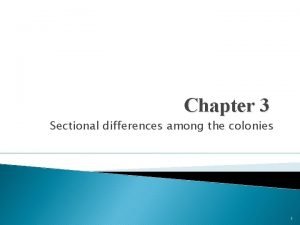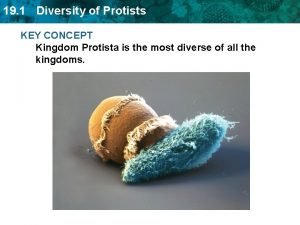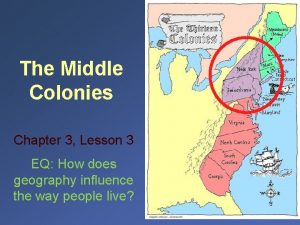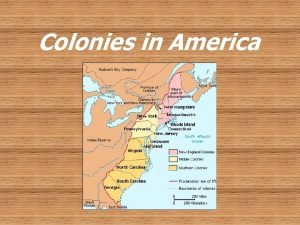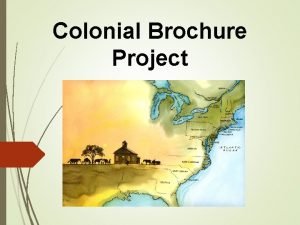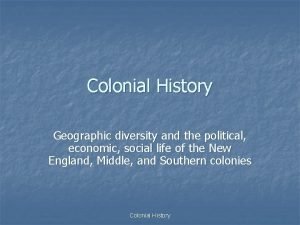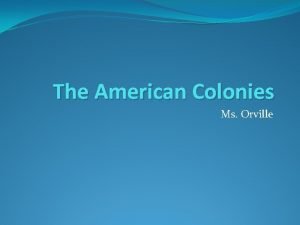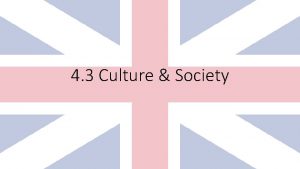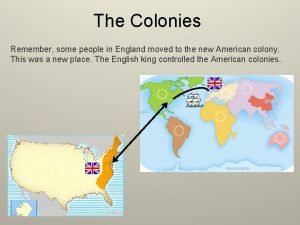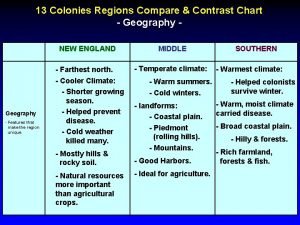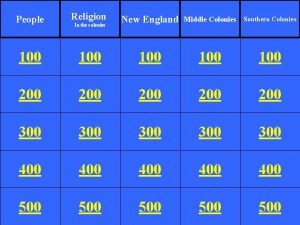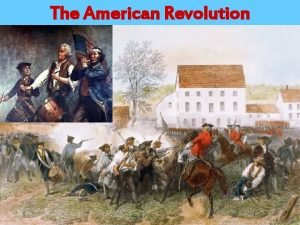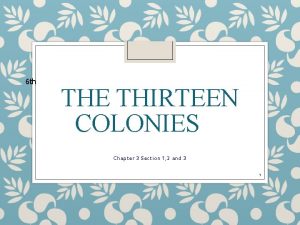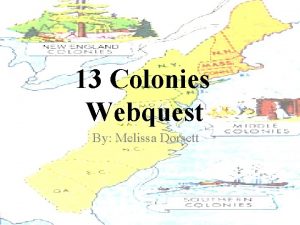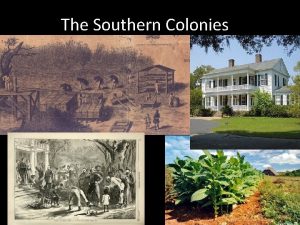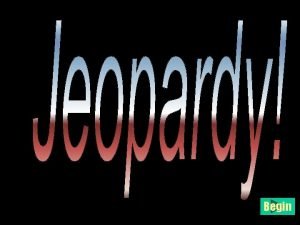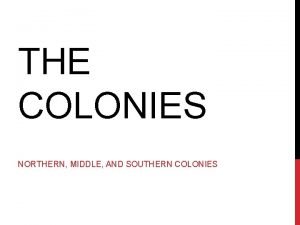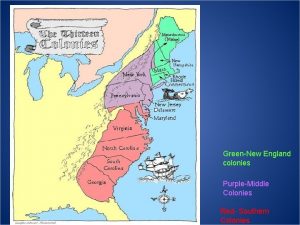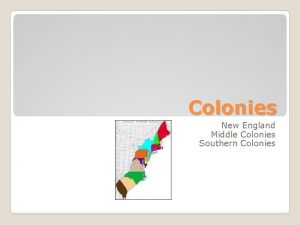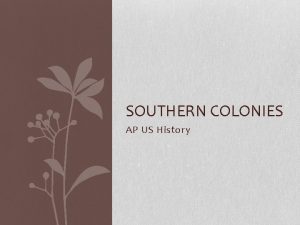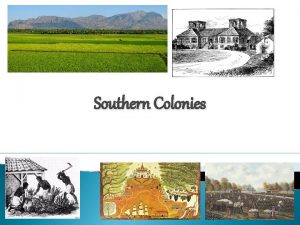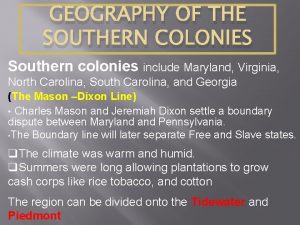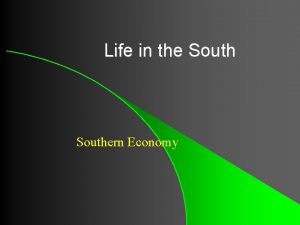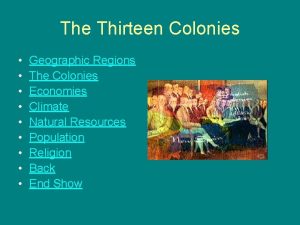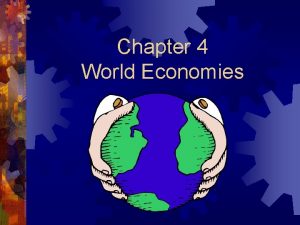Diverse Colonial Economies Southern Colonies This economy was

















- Slides: 17

Diverse Colonial Economies Southern Colonies • This economy was based on staple crops—crops that are in constant crops demand. • Staple crops included tobacco and rice, both grown on large plantations worked by slaves.

Diverse Colonial Economies Middle Colonies • The economy of the Middle Colonies was a mixture of farming and commerce. • Rich, fertile soil produced wheat, barley, and rye. • New York and Philadelphia supported the business of merchants, traders, and craftspeople.

Diverse Colonial Economies New England Colonies • The New England economy relied on “carrying trade. ” • Merchants carried crops and goods from one place to another. • The business of trading goods between the Americas, Europe, and Africa, was called triangular trade.

The Middle Passage • The Middle Passage was one leg of the triangular trade between the Americas, Europe, and Africa. • This term also refers to the forced transport of slaves from Africa to the Americas.

Middle Passage • Roughly 10 to 40 percent of Africans on slave trips died in the crossing. • Slaves were beaten and had to endure chains; heat; and cramped, unsanitary conditions. • Occasionally enslaved Africans staged a mutiny, or revolt, on the slave ships. • Many of these were successful.

Slavery in the Colonies • South Carolina and Georgia • High temperatures and disease made slave conditions especially harsh in this region. • African Americans made up the majority of the population in South Carolina and more than one third of Georgia’s population. • Southern slaves kept their culture alive through their speech, crafts, and music.

Slavery in the Colonies Virginia and Maryland • Slaves in Virginia and Maryland made up a minority of the population. • Few of those slaves came directly from Africa. • Slaves had other tasks in addition to growing crops. • There was more integration of European American and African American cultures than in South Carolina and Georgia. • To save money, slave-owners encouraged slaves to have families.

Slavery in the Colonies New England the Middle Colonies • There were far fewer slaves in New England the Middle Colonies than in the South. • Slaves had more freedom to choose their occupations. • Slaves in this region typically worked as cooks, housekeepers, and personal servants. • They also worked as skilled artisans, dockworkers, merchant sailors, fishermen, whalers, privateers, lumberjacks, and in manufacturing.

Free Blacks • Slaves that earned money as artisans or laborers had the possibility of saving enough to purchase their freedom. Free Blacks • Free African Americans did the same kind of work as enslaved African Americans, but were often worse off economically and socially

Free Blacks • Free blacks faced poorer living conditions and more discrimination than slaves who were identified with specific white households. • Free blacks could not vote, testify in court, or marry whites.

Laws and Revolts Laws • Slaves could not go aboard ships or ferries, or leave the town limits without a written pass. • Slaves could be accused of crimes ranging from owning hogs or carrying canes to disturbing the peace or striking a white person. • Punishments included whipping, banishment to the West Indies, and death.

Western Expansion • In the mid-1700 s, the colonial population was increasing rapidly, nearly doubling every 25 years. • Birth rates were rising.

Western Expansion • Immigrants from England, Ireland, Germany, and other countries were settling in colonial America. • As the population grew, settlers pushed west in search of more land. • These settlers were part of a migration, or movement, in search of land on which they could build independent lives and maintain their households. • Immigrants — people who enter a new country to settle

Native American and French Reaction Native American Response • As white settlers migrated into Indian territory, the Indians were forced to relocate into lands already occupied by other Native American groups. • The Cherokees, Creeks, Chickasaws, and Choctaws put up a powerful struggle to block westward colonial expansion.

Native American and French Reaction French Actions • In 1752, the French built Fort Presque Isle in Pennsylvania and attacked and killed the men defending an English trading post in the Ohio Valley. • By the early 1750 s, it became clear that Pennsylvania would become the setting for a struggle between the colonists, Native Americans, and the French.

The Great Awakening • The Great Awakening refers to a revival of religious feeling that began in the early 1700 s. • These revivals were designed to renew religious enthusiasm and commitment. • Jonathan Edwards — Edwards, a Massachusetts minister, is believed to have started the Great Awakening. • His success inspired other ministers to increase their efforts to energize their followers

The Great Awakening • George Whitefield — Whitefield was an itinerant, or traveling, preacher who toured the colonies seven times between 1738 and 1770. • These ministers preached that any Christian could have a personal relationship with Jesus Christ. • They stated that faith and sincerity, rather than wealth and education, were the major requirements needed to understand the Gospel.
 Economy of southern colonies
Economy of southern colonies Economy of southern colonies
Economy of southern colonies Animal like protists
Animal like protists Colonial america lesson 3 the middle colonies
Colonial america lesson 3 the middle colonies Southern colonies
Southern colonies New england mid atlantic and southern colonies
New england mid atlantic and southern colonies Characteristics of the southern colonies
Characteristics of the southern colonies New england colonies definition
New england colonies definition 13 colonies brochure project
13 colonies brochure project Southern colonies geography
Southern colonies geography Southern colonies
Southern colonies Southern colonies society/culture
Southern colonies society/culture 13 colonies new england middle and southern
13 colonies new england middle and southern Comparing colonies chart
Comparing colonies chart Middle colonies religion
Middle colonies religion Southern colonies
Southern colonies Southern colonies
Southern colonies Melissa dorsett
Melissa dorsett

